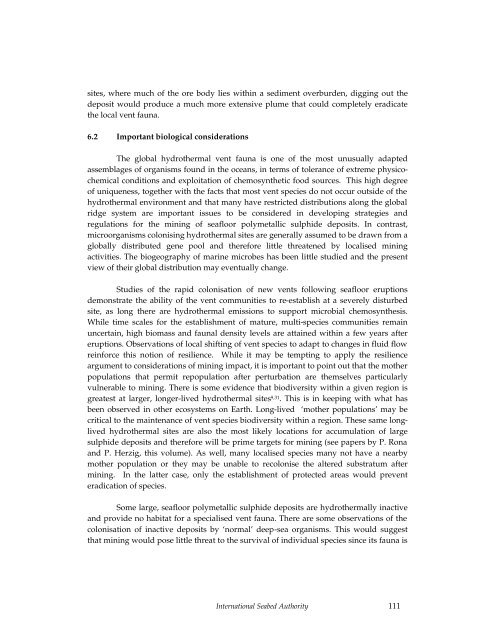Full page fax print - International Seabed Authority
Full page fax print - International Seabed Authority
Full page fax print - International Seabed Authority
Create successful ePaper yourself
Turn your PDF publications into a flip-book with our unique Google optimized e-Paper software.
sites, where much of the ore body lies within a sediment overburden, digging out the<br />
deposit would produce a much more extensive plume that could completely eradicate<br />
the local vent fauna.<br />
6.2 Important biological considerations<br />
The global hydrothermal vent fauna is one of the most unusually adapted<br />
assemblages of organisms found in the oceans, in terms of tolerance of extreme physicochemical<br />
conditions and exploitation of chemosynthetic food sources. This high degree<br />
of uniqueness, together with the facts that most vent species do not occur outside of the<br />
hydrothermal environment and that many have restricted distributions along the global<br />
ridge system are important issues to be considered in developing strategies and<br />
regulations for the mining of seafloor polymetallic sulphide deposits. In contrast,<br />
microorganisms colonising hydrothermal sites are generally assumed to be drawn from a<br />
globally distributed gene pool and therefore little threatened by localised mining<br />
activities. The biogeography of marine microbes has been little studied and the present<br />
view of their global distribution may eventually change.<br />
Studies of the rapid colonisation of new vents following seafloor eruptions<br />
demonstrate the ability of the vent communities to re-establish at a severely disturbed<br />
site, as long there are hydrothermal emissions to support microbial chemosynthesis.<br />
While time scales for the establishment of mature, multi-species communities remain<br />
uncertain, high biomass and faunal density levels are attained within a few years after<br />
eruptions. Observations of local shifting of vent species to adapt to changes in fluid flow<br />
reinforce this notion of resilience. While it may be tempting to apply the resilience<br />
argument to considerations of mining impact, it is important to point out that the mother<br />
populations that permit repopulation after perturbation are themselves particularly<br />
vulnerable to mining. There is some evidence that biodiversity within a given region is<br />
greatest at larger, longer-lived hydrothermal sites 9,31. This is in keeping with what has<br />
been observed in other ecosystems on Earth. Long-lived ‘mother populations’ may be<br />
critical to the maintenance of vent species biodiversity within a region. These same longlived<br />
hydrothermal sites are also the most likely locations for accumulation of large<br />
sulphide deposits and therefore will be prime targets for mining (see papers by P. Rona<br />
and P. Herzig, this volume). As well, many localised species many not have a nearby<br />
mother population or they may be unable to recolonise the altered substratum after<br />
mining. In the latter case, only the establishment of protected areas would prevent<br />
eradication of species.<br />
Some large, seafloor polymetallic sulphide deposits are hydrothermally inactive<br />
and provide no habitat for a specialised vent fauna. There are some observations of the<br />
colonisation of inactive deposits by ‘normal’ deep-sea organisms. This would suggest<br />
that mining would pose little threat to the survival of individual species since its fauna is<br />
<strong>International</strong> <strong>Seabed</strong> <strong>Authority</strong> 111

















